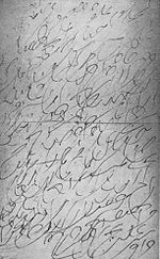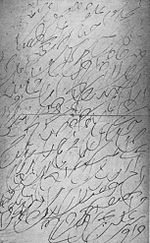
List of writings of Bahá'u'lláh
Encyclopedia
Bahá'u'lláh
, founder of the Bahá'í Faith
, wrote many books, tablets
and prayers, of which only a fraction has been translated into English until now. He revealed thousands of tablets with a total volume more than 70 times the size of the Qur'an and more than 15 times the size of the Old and New Testaments of the Bible.
The below list, organized by the city he was in while he wrote the tablet, is not complete, but only shows the most well-known writings of Bahá'u'lláh.
1857-58
1857-63
1858-63
1862
1863
On the way to Constantinople
1863
1864-66
1864-68
1865
1865-66
1866
1866-68
1867
1867-68
1867-69
1867
On the way to ‘Akká
1868
1868-70
1869
1870-75
1870-77
1871
1873
1873-74
1879-91

1882
1885-88
1888
1891
Bahá'u'lláh
Bahá'u'lláh , born ' , was the founder of the Bahá'í Faith. He claimed to be the prophetic fulfilment of Bábism, a 19th-century outgrowth of Shí‘ism, but in a broader sense claimed to be a messenger from God referring to the fulfilment of the eschatological expectations of Islam, Christianity, and...
, founder of the Bahá'í Faith
Bahá'í Faith
The Bahá'í Faith is a monotheistic religion founded by Bahá'u'lláh in 19th-century Persia, emphasizing the spiritual unity of all humankind. There are an estimated five to six million Bahá'ís around the world in more than 200 countries and territories....
, wrote many books, tablets
Tablet (religious)
A tablet, in the religious context, is a term traditionally used for religious texts.Jews and Christians believe that Moses brought the Ten Commandments from Mount Sinai in the form of two stone tablets. According to the Book of Exodus, God delivered the tablets twice, the first set having been...
and prayers, of which only a fraction has been translated into English until now. He revealed thousands of tablets with a total volume more than 70 times the size of the Qur'an and more than 15 times the size of the Old and New Testaments of the Bible.
The below list, organized by the city he was in while he wrote the tablet, is not complete, but only shows the most well-known writings of Bahá'u'lláh.
Baghdad
1857- Sahífiy-i-Shattíyyih, "Book of the River [Tigris]"
1857-58
- Chahár VádíFour Valleys (Bahá'í)The Four Valleys is a book written in Persian by Bahá'u'lláh, the founder of the Bahá'í Faith. The Seven Valleys was also written by Bahá'u'lláh, and the two books are usually published together under the title The Seven Valleys and the Four Valleys...
, "Four Valleys" - Kalimát-i-MaknúnihHidden WordsKalimát-i-Maknúnih or The Hidden Words is a book written in Baghdad around 1857 by Bahá'u'lláh, the founder of the Bahá'í Faith...
, "Hidden Words"
1857-63
- Haft VádíSeven ValleysThe Seven Valleys is a book written in Persian by Bahá'u'lláh, the founder of the Bahá'í Faith. The Four Valleys was also written by Bahá'u'lláh, and the two books are usually published together under the title The Seven Valleys and the Four Valleys...
, "Seven Valleys" - Hurúfát-i-'Álín, "The Exalted Letters"
- Javáhiru'l-AsrárGems of Divine MysteriesJaváhiru’l-Asrár or Gems of Divine Mysteries, is a book by Bahá'u'lláh, the founder of the Bahá'í Faith. The treatise was written in reply to a question from Siyyid Yúsuf-i-Sidihí Isfahání who had asked the question of how the promised Mihdí could have been "transformed" into the Báb...
, "Gems of Divine Mysteries" - Lawh-i-Áyiy-i-Núr, "Tablet of the 'Light Verse'" [of the Qur'an]), also known as Tafsír-i-Hurúfát-i-Muqatta'ih, "Commentary on the Isolated Letters"
- Lawh-i-Fitnih, "Tablet of the Test"
- Lawh-i-Húríyyih, "Tablet of the Maiden"
- Madínatu'r-Ridá, "City of Radiance/Radiant Acquiescence"
- Madínatu't-Tawhíd, "City of Unity"
- Shikkar-Shikan-Shavand, "Sweet Scented Being"
- Súriy-i-Nush, "Tablet of Advice"
- Súriy-i-Qadír, "Surih of the Omnipotent"
- Asl-i-Kullu'l-Khayr, "Words of Wisdom"
1858-63
- Subhána-Rabbíya'l-A'lá, "Praise to the Exalted Lord"
- Lawh-i-Ghulámu'l-Khuld, "Tablet of the Eternal Youth"
- Húr-i-Ujáb, "The Wondrous Maiden"
- Az-Bágh-i-Iláhí, "From The Garden of Holiness"
1862
- Kitáb-i-ÍqánKitáb-i-ÍqánThe Kitáb-i-Íqán is one of many books held sacred by followers of the Bahá'í Faith; it is their primary theological work. One Bahá'í scholar states that it can be regarded as the "most influential Koran commentary in Persian outside the Muslim world," because of its international audience. It is...
, "The Book of Certitude"
1863
- Lawh-i-Ayyúb, "Tablet of Job"
- Lawh-i-Malláhu'l-QudsTablet of the Holy MarinerLawh-i-Malláhu'l-Quds or the Tablet of the Holy Mariner is a tablet written by Bahá'u'lláh, founder of the Bahá'í Faith, in Baghdad in 1863...
, "Tablet of the Holy Mariner"
On the way to ConstantinopleConstantinopleConstantinople was the capital of the Roman, Eastern Roman, Byzantine, Latin, and Ottoman Empires. Throughout most of the Middle Ages, Constantinople was Europe's largest and wealthiest city.-Names:...
1863
- Lawh-i-Hawdaj, "Tablet of the Howdah [a seat for riding a camel]"
Constantinople
1863- Subhánika-Yá-Hú, "Praised be Thou, O He!," also known as Lawh-i-Naqus, "Tablet of the Bell"
Adrianople
1864- Súriy-i-'Ibád, "Tablet of the Servants/People"
- Lawh-i-Salmán, "First Tablet to Salmán"
1864-66
- Lawh-i-Laylatu'l-Quds, "Tablet of the Sacred Night"
1864-68
- Lawh-i-Siráj, "Tablet for Siraj"
- Mathnavíy-i-Mubárak, "Blessed Mathnaví [collection of poetry]"
- Súriy-i-Asháb, "Surih of the Companions"
- Súrihs of HajjBahá'í pilgrimageA Bahá'í pilgrimage currently consists of visiting the holy places in Haifa, Akká, and Bahjí at the Bahá'í World Centre in Northwest Israel. Bahá'ís do not have access to other places designated as sites for pilgrimage....
, "Tablets of Pilgrimage"
1865
- Lawh-i-AhmadTablet of Ahmad (Arabic)Lawh-i-Ahmad or Tablet of Ahmad is a tablet written by Bahá'u'lláh, founder of the Bahá'í Faith in Adrianople in 1865. In a letter written on his behalf, Shoghi Effendi has stated that it has been 'invested by Bahá'u'lláh with a special potency and significance'.-External links:* .*...
, "Tablet of Ahmad," Arabic - Lawh-i-Ahmad, "Tablet of Ahmad," Persian
1865-66
- Lawh-i-Bahá, "Tablet of Glory"
- Súriy-i-Damm, "Tablet of Blood"
1866
- Lawh-i-Rúh, "Tablet of Spirit"
- Lawh-i-Khalíl, "Tablet to Jinab-i Khalil ["the friend"]"
1866-68
- Lawh-i-Ashraf, "Tablet to Ashraf ["the noble"]"
- Lawh-i-Nasír, "Tablet to Nasír ["the defender"]"
1867
- Lawh-i-Sayyáh, "Tablet of the Traveller"
1867-68
- Súriy-i-Mulúk, "Tablet to the Kings"
- Kitáb-i-Badí', "Wondrous/Unique Book"
- Súriy-i-GhusnTablet of the BranchThe Súrih-i-Ghusn or Tablet of the Branch a tablet written by Bahá'u'lláh, founder of the Bahá'í Faith in Adrianople. It clearly confirms a clearly high station for "the Branch of Holiness" .-See also:*Kitáb-i-Aqdas...
, "Tablet of the Branch"
1867-69
- Lawh-i-Sultán, "Tablet to the Sultan [Nasiri'd-Din Shah]"
1867
- Lawh-i-Napulyún, "First Tablet to Napoleon III"
On the way to ‘AkkáAcre, IsraelAcre , is a city in the Western Galilee region of northern Israel at the northern extremity of Haifa Bay. Acre is one of the oldest continuously inhabited sites in the country....
1868
- Súriy-i-Ra'ís, "Tablet of the Premier/President [Ali Pasha]"
'Akká
1868- Lawh-i-Salmán II, "Second Tablet of Salmán"
- Lawh-i-Ra'ís, "Tablet to the Premier/President/Chief [Ali Pasha]"
1868-70
- Lawh-i-Malik-i-Rus, "Tablet to Tsar Alexander II"
- Lawh-i-Malikih, "Tablet to Queen Victoria"
- Lawh-i-Pisar-'Amm, "Tablet to the Cousin"
1869
- Lawh-i-Ridván, "Tablet of Ridván"
- Lawh-i-Fu'ád, "Tablet to Fu'ád Páshá"
- Lawh-i-Napulyún, "Second Tablet to Napoleon III
- Lawh-i-Páp, "Tablet to Pope Pius IX"
- Súriy-i-Haykal, "Tablet of the Temple/Body"
1870-75
- Lawh-i-TibbLawh-i-TibbLawh-i-Tibb, Tablet to a Physician or Tablet of Medicine is a tablet of Bahá'u'lláh to Áqá Mírzá Muhammad-Ridáy-i-Tabib-i-Yazdí, a doctor of the old school of medicine...
, "Tablet to the Physician/Tablet of Medicine"
1870-77
- Lawh-i-Mánikchí SáhibTabernacle of UnityThe Tabernacle of Unity is a small book, first published in July 2006, containing Bahá'u'lláh's Tablet, from the early `Akká period, to Mánikchí Ṣáḥib, a prominent Zoroastrian, and a companion Tablet addressed to Mírzá Abu'l-Fadl, the secretary to Mánikchí Ṣáḥib at that time.These, together with...
, "Tablet to Mánikchí" - Lawh-i-Haft PurshishTabernacle of UnityThe Tabernacle of Unity is a small book, first published in July 2006, containing Bahá'u'lláh's Tablet, from the early `Akká period, to Mánikchí Ṣáḥib, a prominent Zoroastrian, and a companion Tablet addressed to Mírzá Abu'l-Fadl, the secretary to Mánikchí Ṣáḥib at that time.These, together with...
, "Tablet of Seven Questions"
1871
- Lawh-i-Qad Ihtaraqa'l-MukhlisúnFire TabletLawh-i-Qad-Ihtaraqa'l-Mukhlisun,' better known as the Fire Tablet, is a tablet written in Arabic by Bahá'u'lláh, founder of the Bahá'í Faith in 'Akká in 1871. Bahá'u'lláh wrote the tablet in response to questions by a Bahá'í believer from Iran...
, "The Fire Tablet"
1873
- Kitáb-i-AqdasKitáb-i-AqdasThe Kitáb-i-Aqdas is a central book of the Bahá'í Faith written by Bahá'u'lláh, the founder of the religion. The work was written in Arabic under the Arabic title , but it is commonly referred to by its Persian title, Kitáb-i-Aqdas , which was given to the work by Bahá'u'lláh himself...
, "The Most Holy Book" - Lawh-i-Ru'yá, "Tablet of Vision"
1873-74
- Lawh-i-Hikmat, "Tablet of Wisdom"
Mazra’ih and Bahjí
1877-79- Lawh-i-Burhán, "Tablet of the Proof"
1879-91

- Tajallíyát, "Effulgences"
- Bishárát, "Glad-Tidings"
- Lawh-i-Ittihád, "Tablet of Unity"
- Súriy-i-Vafá,"Tablet to Muhammad Husayn, 'Vafá'" ["fidelity"]
- Kalimát-i-Firdawsíyyih, "Words of Paradise"
- Lawh-i-Aqdas, "Most Holy Tablet"
- Lawh-i-Ard-i-Bá, *"Tablet of the Land of 'B' [Beirut]"
- Kitáb-i-`Ahdí, "Book of My Covenant"
- Lawh-i-Dunyá, "Tablet of the World"
1882
- Lawh-i-Maqsúd, "Tablet of The Desired One [maqsúd]"
1885-88
- Ishráqát, Splendours"
1888
- Tarázát, Ornaments"
1891
- Lawh-i-Times, "Tablet to The Times"
- Lawh-i-Karmil, "Tablet of [Mount] Carmel"
- Lawh-i-Ibn-i-DhibEpistle to the Son of the WolfThe Epistle to the Son of the Wolf is the last major work of Bahá'u'lláh, founder of the Bahá'í Faith, before his death in 1892. It is a letter written to a Muslim cleric, a violent opponent of the Bahá'ís who, along with his father , also a Muslim cleric, had put to death a number of Bahá'ís...
, "Epistle to the Son of the Wolf"

